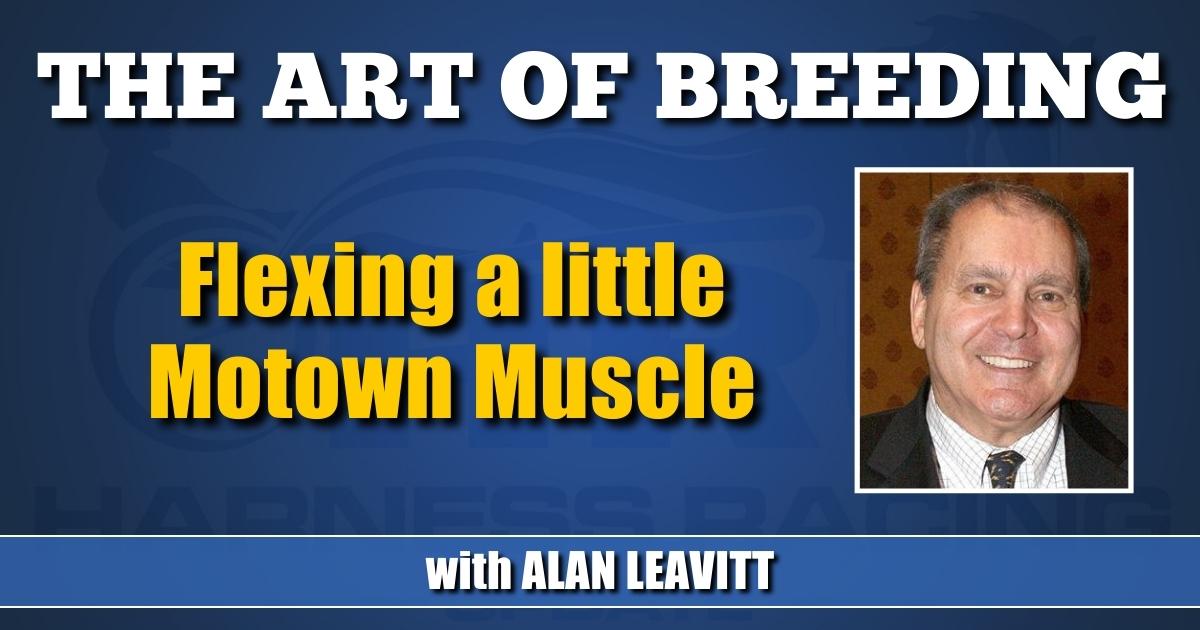

Flexing a little Motown Muscle
by Alan Leavitt
As someone who always tries to fish where the fish are, in this case it means taking a hard look at the top 3-year-old trotting colt and the leading 2-year-old trotting filly in the lucrative Ontario Sires Stakes program.
That means, respectively, the 3-year-old gelding Duly Resolved 3, 1:54 1/5 ($654,120), and the 2-year-old filly Righteous Resolve 2, 1:53 1/5 ($324,748). The similarities between the two are striking. They’re both by the same sire, Resolve, they’re both out of the same mare, Motown Muscle, and they’re both trained by Jon Bax. In other words, full siblings.
Motown Muscle, the dam of Duly Resolved and Righteous Resolve, has already stamped herself as a great producer from only her first four foals with those two, plus the mare Bright Eyes M with a record at 3 of 1:53 and earnings of $239,589.
M² has an interesting pedigree, starting with her sire, Muscle Mass. He is a living proof that a stallion’s 2-year-old racing season is the best foreshadowing of his future potential as a sire.
Muscle Mass was a top stakes colt at 2, winning just under $200,000. At 3 he couldn’t beat Old Shep, barely eking out $30,000. Today, he is one of the best trotting sires in North America.
Muscle Mass has a full brother, Muscle Massive, who was no hell at 2, but won our biggest dance, the Hambletonian at 3. Let me hasten to say Muscle Massive is a good sire himself, but he’s now on his second farm.
So that you don’t regard me as a Lonely Only when it comes to pronouncements about 2-year-old brilliance being essential to future success in the stud, the greatest thoroughbred breeder of all time, Federico Tesio, felt the same way.
Perhaps the single most important aspect of Tesio’s breeding program was his ability to track down obscure runners who were brilliant at 2, and from them breeding European champions. Tesio’s masterpiece was the superhorse, Ribot, not only unbeaten, but unheaded in his racing career.
Here, a personal note RE: Ribot. He came to stand in America on a two-year-lease to Darby Dan Farm, owned by John Galbreath, owner of the Pittsburg Pirates, among quite a number of other possessions. Darby Dan was managed by Olin Gentry, and in my early days he and I became friends.
Ribot was supposed to return to Italy at the end of his second U.S. breeding season, but that never happened. Galbreath desperately wanted to keep Ribot. He concocted a story that since he came to the United States, he had become such a wild horse that if he were ever loaded on a plane, he would go crazy and have to be put down before he brought the plane down.
The supporting evidence for this claim was a picture of Robot on his hind legs, striking out wildly with his front legs, his eyes with a wild gleam that owed a little to nature and a lot to a retouching job by Tony Leonard, probably the greatest equine photographer of all time.
One day when I had dropped by Darby Dan, my friend Olin Gentry took me out to Ribot’s paddock. There was a big tree in the middle of it, and Ribot was standing on his hind legs, happily eating leaves off the tree.
“That’s how we got that picture,” Gentry told me. “Thank goodness that horse liked the taste of those leaves.”
Back from Memory Lane, and on to Motown Muscle’s extended pedigree:
It’s an interesting pedigree, indeed, and finally one that bear’s out this kid’s belief in the value of judicious close breeding.
Motown Muscle is by Muscle Mass, who’s by Muscle Yankee, and he by Valley Victory. Her dam is Bankers Jackpot, by Wall Street Banker, and a full brother to Valley Victory, so M² is 2 by 3 to two full siblings, which makes her Inbred.
As a gentle reminder, if the sum of the two generations in which the same name appears is six or less, that is properly defined as Inbreeding. In the case of M², the sum of the two generations in which Valley Victory and his full brother, Wall Street Banker, appears is five. Obviously the potency of such a close cross is self-evident in M²’s dynamite production.
For good measure, Motown Muscle is also 3 by 4 to Speedy Crown, and when the sum of the two generations in which the same name appears is seven or eight, that is the definition of Line Breeding.
When no name appears twice for a total of eight generations, or less, that horse so bred is defined as an Outcross.
The great majority of today’s trotters and pacers are Outcrosses. The potential for explosive production is clear when one sees the top racehorses an Inbred mare like Motown Muscle has produced.
Parenthetically, a quick “Hello” to my good friend Bob Brady, who told me he has finally absorbed my definitions. So now there’s at least two of us.
Booking season has already started, and I have to wonder if there will be any Inbreeding planned. Not that they’re asking my advice, but some of the big outfits always have some mares that haven’t yet produced up to expectations. They would be prime candidates for judicious Inbreeding. There’d be nothing to lose, and it could get a potentially good mare on her way to finally paying her way, and then some.
Finally, in my distant youth I trained and showed my father’s saddle horses. My hero then, and remains so still today, was Earl Teater.
He trained the saddle horses for Francis Dodge Van Lennep’s Castleton Farm, under the nom de course of Dodge Stables. His masterpiece was the six times world champion five-gaited stallion, Wing Commander.
When I got old enough to hang at the edge of the small crowd that was always around Earl, I hung on every word he said. And finally I graduated to the point that I actually could carry on a conversation with him, although I always made sure that he did most of the talking.
Teater had a dry, rasping voice, and one time we walked out of Madison Square Garden together early in the morning, to go together for breakfast.
“Taxi!” Earl rasped as we hit the street, and I think a dozen cabs must have squealed to a stop.
It all came back to me one day at the Lexington sale this week. Someone asked me how old Constance Hall was, and suddenly it was 60 years ago, and I was asking Teater how old Belle of the Dell was.
And just as the answer I got all those years ago, I plagiarized Teater, and answered in the deepest voice I could come up with;
“She’s old enough to sleep by herself!”















